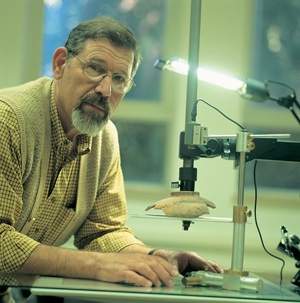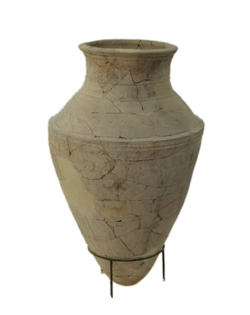Are you a journalist? Please sign up here for our press releases
Subscribe to our monthly newsletter:

How smart were the hominids who inhabited our planet 1.5 millions years ago? Did the Phoenicians destroy the Mediterranean port of Dor? Until recently, you wouldn’t have expected Weizmann Institute research to throw light on such questions, but today’s Institute scientists are involved in a number of archaeological studies, including several conducted in an unlikely venue - a physics lab.
Prehistoric axes and pieces of ancient pottery began to appear in Weizmann’s physics building about three years ago, after Prof. Uzy Smilansky celebrated his 60th birthday by taking his family to work at an archaeological dig in Ein Gedi. Smilansky, of the Physics of Complex Systems Department, had been fascinated by archaeology ever since he volunteered at the excavation of Massada in the 1960s during his army service. Returning to this lifelong interest, he set out to develop an objective, computerized method for analyzing large amounts of archaeological data.
One area of archaeology where computers might prove invaluable is the study of pottery - which provides a wealth of information about past civilizations, helping to date excavated layers, reveal social customs and trace trade relations. Sorting and classifying pottery finds is, however, an overwhelming task. Excavations generally churn up thousands of pieces of broken clay pots. Moreover, the use of artists to hand-draw the pottery shards potentially introduces a bias. Smilansky attacked these problems together with two archaeologists, Drs. Ayelet Gilboa of the University of Haifa and Ilan Sharon of the Hebrew University of Jerusalem, and graduate student Avshalom Karasik, who has a joint bachelor’s degree in archaeology and mathematics.
To produce objective digital images of pottery pieces, the scientists used a profilograph, a device that traces the outline of an object and transmits it to a computer. Next, they analyzed the resulting images using a mathematical algorithm that sorts the objects according to their curvature.
Initial results have proven promising. One of the studies examined findings from Dor - today a popular beach north of Tel Aviv, but in the distant past a bustling Mediterranean port and commercial hub.

Dor was excavated for two decades under the direction of Hebrew University’s Prof. Ephraim Stern and is now being explored under the guidance of Gilboa and Sharon. The digging had revealed layers belonging to the 12th and 11th centuries BCE, separated by a thick layer of debris.
Archaeologists assumed that the debris signaled a sweeping change in population: The Phoenicians, who conquered Dor from the Sea People in the 11th century BCE, had apparently wrought widespread destruction. However, a computer analysis revealed that the pottery had undergone a continuous evolutionary change during the 12th and 11th centuries BCE, thus putting into question the effect of the Phoenician conquest on the local population. “Obviously, you can’t draw sweeping conclusions from this finding, but it does support the notion of cultural continuity. At the very least, the art of pottery continued to be passed on from father to son,” says Gilboa.
Another study offers a look into the brain power of our prehistoric ancestors by examining early Stone Age handaxes, found in abundance in Israel. The ones studied by the scientists were apparently left behind about 1.5 million years ago by Homo erectus migrating from Africa to Asia and Europe.
Smilansky, Karasik and Sharon, working with postdoctoral fellow and prehistorian Dr. Idit Saragusti, found that at three of the sites studied, the axes showed enhanced symmetry and smoothness over time - a finding that suggests the evolution of cognitive skills, since the ability to generate symmetry requires a certain degree of sophistication.
Since word of the new method got out, Smilansky has been approached by archaeologists in Israel and abroad and is currently involved in half a dozen collaborative projects. If the method’s popularity continues to grow, archaeological exhibits are likely to become a routine fixture in the Institute’s physics building.
This research was supported by a Bikura Grant from the Israel Science Foundation and by the Helen and Martin Kimmel Center for Archaeological Sciences at the Weizmann Institute. Prof. Smilansky’s research is supported by the J & R Center for Scientific Research and the Minerva Center for Nonlinear Physics of Complex Systems. He is the incumbent of the Professor Wolfgang Gentner Professorial Chair of Nuclear Physics.